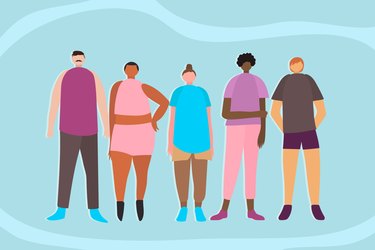
Heart disease is the leading cause of death in the United States, and it doesn't discriminate.
In 2021, about 695,000 people in the United States died due to the condition, according to most recent data from the Centers of Disease Control and Prevention (CDC).
Video of the Day
Video of the Day
While certain modifiable lifestyle factors can make someone more at risk, others we can't change. For one, a growing body of research suggests LGBTQIA+ adults are more likely to have worse heart health than heterosexual, cisgender adults.
Lesbian, gay and bisexual adults were 36 percent less likely than heterosexual adults to have ideal heart health, based on risk factors like smoking and blood sugar levels, according to preliminary research presented at the American Heart Association's (AHA) March 2018 meeting.
Three years later in July 2021, the AHA published a study in Circulation sharing more findings of high rates of heart disease among transgender and gender diverse people compared to cisgender people.
It's thought that these poor health outcomes are at least partially linked to the stress that comes from discrimination and transphobia, according to Geoffrey Barnes, MD, a cardiologist and associate professor of internal medicine at the University of Michigan Health System.
Health care disparities, risk factors and discrimination towards LGBTQIA+ adults are complex issues, Dr. Barnes says. And solutions need to be addressed at systemic, societal and individual levels.
A Note on Language
Here at LIVESTRONG.com, we carefully consider language surrounding sex, gender and sexual orientation. We use the acronym "LGBTQIA+" when referring to sexual orientation or gender identities, but you may see other acronyms throughout this article when they were used by a primary source.
Why the LGBTQIA+ Community Has a Higher Risk of Heart Disease
"Anytime you have a marginalized community, there are a lot of factors at play," says Jennifer Huang, MD, a cardiologist and associate professor of pediatrics at Oregon Health and Science University.
"LGBTQIA+ people often deal with different types of stress, avoidance of health care and familial rejection, and they tend to have lower socioeconomic status. There's a lot of intersectionality."
1. Smoking and Obesity Rates Are Higher
Both tobacco use and obesity are important risk factors for heart attack and stroke, Dr. Barnes says. Cigarettes can damage the heart and blood vessels, which increases your risk for heart conditions, including heart attacks. And the nicotine in cigarettes also raises blood pressure, another heart disease risk factor.
Obesity is linked with diabetes and high cholesterol, which are also risk factors for heart disease, according to the CDC.
Smoking is more common among lesbian, gay and bisexual adults in the U.S., according to the CDC: About 15 percent smoke cigarettes, compared to about 11 percent of heterosexual adults.
A January 2017 study in the American Journal of Preventive Medicine found cigarette smoking is also higher among transgender adults, with nearly 36 percent smoking, compared to 21 percent of cisgender adults.
As for obesity, in a May 2019 study in the International Journal of Environmental Research and Public Health, researchers found lesbian and bisexual women are more likely to have obesity, while gay men are less likely to have obesity than their heterosexual counterparts.
2. Preventive Care Rates Are Lower
Many LGBTQIA+ people don't get frequent preventive health care — for a variety of reasons, Dr. Barnes says.
"LGBTQ+ individuals experience higher rates of discrimination and stress in general, and many are fearful that they will experience similar types of discrimination within the health care system," he says.
According to survey data from the Center for American Progress (CAP), 7 percent of LGBTQIA+ respondents said they avoid or postpone preventive health screenings.
Negative experiences with the health care system may lead to skipped doctors appointments, which makes it harder to manage conditions like high blood pressure, high cholesterol and diabetes, Dr. Barnes says.
3. Discrimination and Stress Are More Likely
When LGBTQIA+ folks do seek health care, they may experience real discrimination, Dr. Barnes says.
LGBTQIA+ people are more likely to face mistreatment and discrimination at the doctor's office compared to their heterosexual and cisgender counterparts, according to CAP data. Negative experiences include being intentionally misgendered or denied care because of their identity. Instead of finding a safe environment, many LGBTQIA+ people are placed in stressful and unsafe situations when they go to the doctor.
The relationship between this kind of stress or discrimination and negative health outcomes is often referred to as minority stress theory, and it doesn't only affect racial or ethnic minorities: In a December 2020 study in the International Journal of Behavioral Medicine, researchers concluded sexual minorities experience unique stressors that can have a direct effect on heart health.
"Higher levels of stress in general can have physiologic impact on individuals, including higher blood pressure and changes to behavior, including less exercise and a less healthy diet," Dr. Barnes says.
4. Barriers to Health Insurance Persist
No matter your identity, health care can be expensive in the U.S. And even with health insurance, costs can pile up and create a financial burden. But for LGBTQIA+ people, barriers to inclusive health insurance make health care even more difficult.
Forty-four percent of the LGBTQIA+ population in the U.S. lives in states that do not have inclusive insurance protections, according to the advocacy organization GLMA: Health Professionals Advancing LGBTQ Equality. This can lead to being denied or excluded from insurance coverage unfairly.
GLMA also reports that 43 percent of the LGBTQIA+ population lives in states that do not prohibit transgender exclusions in health insurance service coverage. This means transgender folks can be legally excluded from having their health care covered by insurance.
The cost of care can be a major burden and deterrent for LGBTQIA+ people to find care, including for conditions like high cholesterol, high blood pressure or other factors that may contribute to worsening heart health over time.
What About Hormone Therapy?
Some trans people who use hormones to medically transition may have a higher risk of heart disease connected to hormone use, especially estrogen, Dr. Barnes says.
While more research is needed, there appears to be an association between the use of estrogen by trans women and an increased risk of heart attack and stroke, according to a October 2019 study in Hypertension. There did not appear to be any association between the use of testosterone by trans men and heart health, but there is still very limited research in both scenarios.
How to Maintain Heart Health
Both the health care system and LGBTQIA+ individuals themselves can work together to improve the health of this community, Dr. Barnes says.
While systemic changes need to be made, there are some steps you can take to protect your heart health in the meantime.
1. Find a Health Care Provider You Trust
Finding a doctor who makes you feel comfortable and accepts you is essential. Dr. Huang suggests seeking medical advice that can be tailored to your needs and preferences.
It might take time to build trust with your health care team, but the more honest you are about your life, the better and more precise your care can be.
"It's hard for a provider to give you good care if they don't know you," Dr. Huang says. "It might feel like a safer choice to hide, but the more you share, the better care."
2. Know Your Risk Factors
Everyone — including LGBTQIA+ folks — would benefit from understanding any heart disease risk factors they might have, including tobacco use, high blood pressure, high cholesterol and diabetes, Dr. Barnes says. "If there are opportunities to improve these risk factors, working with health care providers can greatly improve LGBTQ+ individuals' health."
This could look like quitting smoking, improving blood pressure control and potentially losing weight.
3. Get Active
It's no surprise physical activity can help keep your heart healthy. Adults should aim for 30 minutes of moderate activity five days a week, per the CDC.
You can meet this goal by doing regular aerobic exercise like brisk walking, riding a bike, climbing stairs, jumping rope or swimming, for example. The best activity is the one you enjoy and will do consistently.
4. Maintain a Balanced Diet
A diet that's made up of mostly whole foods (fruit, vegetables, whole grains and lean meats) is much healthier than one made up largely of processed food (fried foods, baked goods, packaged snacks, etc.).
To promote heart health, aim to limit saturated and trans fats as much as possible, according to the American Heart Association. Trans fats increase LDL (or "bad") cholesterol levels and lower HDL (or "good") cholesterol. Increased LDL cholesterol and lower HDL cholesterol is linked to a higher risk of heart disease.
- CDC: "Heart Disease Facts"
- CDC: "Lesbian, Gay, Bisexual, Transgender, and Queer (LGBTQ+) People"
- International Journal of Environmental Research and Public Health: "Overweight and Obesity among Sexual Minority Adults in the United States"
- Center for American Progress: "Discrimination Prevents LGBTQ People From Accessing Health Care"
- GLMA: "Equality Maps: Healthcare Laws and Policies"
- CDC: "How Much Physical Activity Do Adults Need?"
- AHA: "The Skinny on Fats"
- Circulation: "Assessing and Addressing Cardiovascular Health in People Who Are Transgender and Gender Diverse: A Scientific Statement From the American Heart Association"
- American Journal of Preventive Medicine: "Transgender Use of Cigarettes, Cigars, and E-Cigarettes in a National Study"
- International Journal of Behavioral Medicine: "Minority Stress and Cardiovascular Disease Risk Among Sexual Minorities: Mediating Effects of Sense of Mastery"
- Hypertension: " Gender-Affirming Hormone Therapy, Vascular Health and Cardiovascular Disease in Transgender Adults"
Is this an emergency? If you are experiencing serious medical symptoms, please see the National Library of Medicine’s list of signs you need emergency medical attention or call 911.













